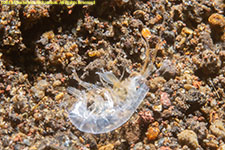 Amphipod
AmphipodCrustaceans:
Amphipods have no carapace and a generally laterally compressed body. The body of an amphipod is composed of thirteen segments. The head is fused to the thorax and bears two pairs of antennae.
True crabs have greatly reduced abdomens and tails, which are kept folded back under their large, rounded, and oten flattened carapace. They have four pairs of visible walking legs. Most do not have noticeable antennae.
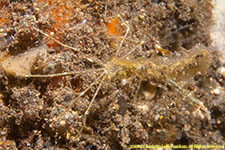 Long snout elbow crab, Lambrachaeus ramifer
Long snout elbow crab, Lambrachaeus ramifer
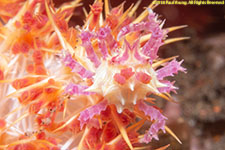 Soft coral crab, Hoplophrys oatesii
Soft coral crab, Hoplophrys oatesii
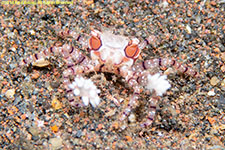 Mosaic boxer crab, Lybia tesselata
Mosaic boxer crab, Lybia tesselata
Porcelain crabs look much like true crabs, but appear to have only three pairs of walking legs. The last pair of legs is greatly reduced and hidden beneath the carapace. Their flexible, crab-like abdomen is not as compact as true crabs, and is kept tucked under the body. Unlike true crabs they have a long pair of antennae.
Shrimps have long hair-like antennas and latterly compressed bodies with long muscular abdomens bearing fringed swimmerets. The antennas are used for locating food as well as recognizing other individuals and their sexes. The antennas are regularly groomed. Cleaner shrimps feed by removing parasites, dead tissue, and bacterial debris from fishes. Many shrimp are symbiotic, living exclusively in association with host invertebrates such as anemones, sea urchins, and feather stars.
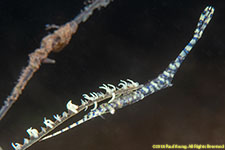 Banded tozeuma shrimp, Tozeuma armatum
Banded tozeuma shrimp, Tozeuma armatum
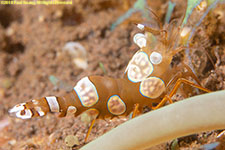 Squat shrimp, Thor amboinensis
Squat shrimp, Thor amboinensis
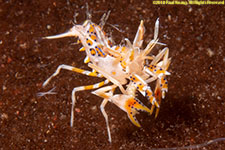 Spiny tiger shrimp, Phyllognathia ceratophthalmus
Spiny tiger shrimp, Phyllognathia ceratophthalmus
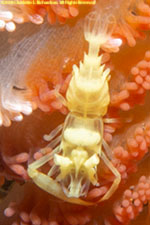 Horned sea pen shrimp, Dasycaris ceratops
Horned sea pen shrimp, Dasycaris ceratops
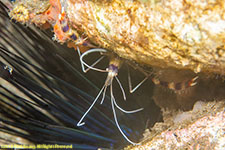 Banded coral shrimp, Stenopus hispidus
Banded coral shrimp, Stenopus hispidus
Isopods are flattened and have seven pairs of similar walking legs with no claws on the first pair. Instead of a true carapace, a small cephalic plate covers the head, which has two pairs of antennae and compound eyes.
Skeleton shrimp are not true shrimp. They are actually amphipods. They typically live in groups from dozens to thousands. Males are much larger than females. They have long thin jointed bodies with two sets of antennae, large grasping claws, and saclike gills. Instead of legs, backward-facing hooks extend from the last three body segments, allowing them to move much like inchworms. From brooding pouches on their abdomens, females bear live young that cling to their mothers for several weeks.
 Skeleton shrimp, Caprella spp.
Skeleton shrimp, Caprella spp.
Squat lobsters are not lobsters, and are more closely related to porcelain crabs and hermit crabs. They have flattened bodies with very long claws and arms which they tend to hold straight forward. Like true crabs the abdomen is typically folded under itself. They appear to have three pairs of walking legs because the last pair is greatly reduced and kept folded beneath the abdomen.
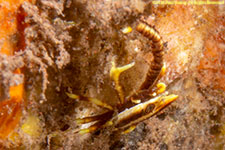 Elegant crinoid squat lobster, Allogalathea elegans
Elegant crinoid squat lobster, Allogalathea elegans
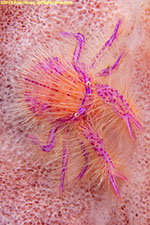 Hairy squat lobster, Lauriea siagiani
Hairy squat lobster, Lauriea siagiani
Mantis shrimps look like praying mantis insects. They are not actually shrimps. They have large stalked eyes and three pairs of walking legs. They have large powerful claw arms, which are normally held in the folded position, poised to strike. There are two types of mantis shrimps based on their claw arms: smashers, which have blunt raptorial appendages for breaking shells for food, and spearers, which have which have long raptorial back-folded appendages for grasping prey. Many spearers hunt from the entrance of their burrows, while smashers often prowl in the open during the day.
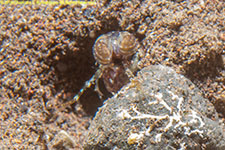 Checkered-eye mantis, Pseudosquilla ciliata
Checkered-eye mantis, Pseudosquilla ciliata
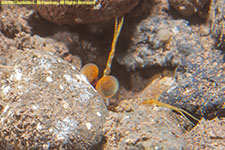 Pink-eared mantis, Odontodactylus latirostris
Pink-eared mantis, Odontodactylus latirostris
©2019, 2024 Mermaid Underwater Photographic. All Rights Reserved.
Contact us at mermaid@underwater.org.
Last modified 30 October 2024